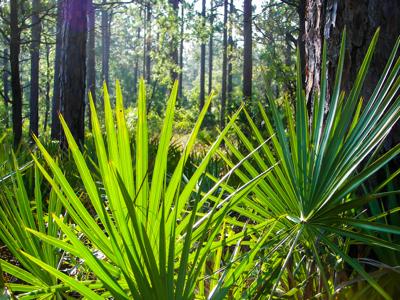The Christian name “Palm Sunday” for the Sunday before Easter comes from the Gospel of John that reports people cut palm fronds and met Jesus on his way to Jerusalem for the Passover. The Gospels of Mark and Matthew don’t mention palms. In these versions of the story, people cut branches and laid them on the road ahead of Jesus.
Many Charleston churches use local palm fronds obtained from sweetgrass basket weavers for Palm Sunday. Basketmakers weave strips of palmetto palm leaves between coils of sweetgrass to hold baskets securely together. Cabbage palmetto will eventually start to form a trunk by producing fibers around the leaf stem bases.

Three types of fan palms are common along the South Carolina coastal plain and can be found throughout the state wherever soil and moisture conditions allow them to grow. Cabbage palmetto (Sabal palmetto), or usually just palmetto, is the only one of the three that grows as a tree, 30 to a maximum 90 feet tall. “Palmetto” comes from the Spanish word for “little palm.
” It is the state tree of South Carolina and Florida. Resistant to hurricane damage, it is planted heavily in Charleston, Savannah and other coastal southeastern cities. According to the South Carolina Department of Natural Resources , the growing point or “palm heart” is edible and tastes like cabbage or artichoke.
Dwarf palmetto (Sabal minor) is a related, smaller palm up to 9 feet tall, found primarily as an understory plant in native coastal plain forests in areas that occasionally flood. Its native range, however, spreads as far west as Oklahoma, demonstrating how tough and adaptable it is. Dwarf palmettos flower in late spring to early summer and produce blue-black berries.
Dwarf palmetto is the easiest of the three fan palms to identify, because plants will flower when they are several years old. One or more flower stalks arise from the base of the plant and bear cream-colored flowers that turn into green and then blue-black berries about a quarter-inch in diameter. Saw palmetto (Serenoa repens) looks similar to dwarf palmetto and grows to a similar size, 4-7 feet tall.
The leaf segments are fused only at the base, whereas the segments of dwarf palmetto fronds are fused for a quarter to a third of the length. The common name “ saw palmetto ” comes from sharp teeth along the leaf stems. The species name “repens” means “creeping,” which is appropriate because saw palmetto can grow into clumps of plants connected by underground stems.
This palm is found from South Carolina west to Louisiana. My interest in native fan palms stems from their abundance in my suburban Charleston yard. They are clustered under river birch and willow oak trees but come up near almost every tree.
All three fan palms produce fruits that are attractive to fruit-eating birds, particularly mockingbirds, which seem to be the most likely culprits for spreading seeds to yards. A spear-like point is visible on fan palms in the genus Sabal at the top of the leaf stem where it joins the fronds. My initial reaction was to let the palms grow, since they are native, free and fit with my cottage garden style.
This nonchalant approach is risky, however, because it is difficult to tell the difference between cabbage and dwarf palmettos until it becomes a chore to remove unwanted ones. Seedlings of all three fan palms are identical. They emerge in the spring and summer as a single, narrow green leaf, the easiest stage to remove them.
Cabbage palmettos start to develop a trunk when they are 10-15 years old. Tan to grayish fibers connect the bases of leaves at ground level. At this stage, they are difficult or impossible to remove by hand-digging.
The best way I’ve found to eliminate plants is to cut off all fronds and the center growing point, then apply glyphosate (Roundup and generic products) to all cut surfaces. It may be necessary to re-treat the growing point. The Charleston-Berkeley-Dorchester Master Gardeners are holding their 2025 plant sale from 10 a.
m.-2 p.m.
on Saturday, April 26 at the Citadel Mall outside the TEACH center near Belk. Cash or check is the preferred payment method. Homeowners can bring a soil sample (three dry cups) to be sent to the Clemson Ag Service Lab.
.
Technology

Gardening column: 3 native Lowcountry palms for Palm Sunday

Today is "Palm Sunday" in reference to the reports people cut palm fronds and met Jesus on his way to Jerusalem for the Passover. Being a Charleston staple for years, it's important to know the three types of fan palms...















